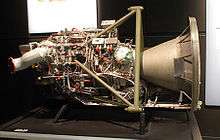S-310
S-310 is a Japanese sounding rocket.
The S-310 is a middle-size rocket for carrying various payloads. It is a single-stage sounding rocket, 310 mm in diameter, and can reach an altitude of 200 km. Its predecessor, the S-300, was developed for observations in Antarctica, in parallel with the S-210, and reached 160 km altitude in its first flight in the fall of 1966 (PT-300). Two out of three succeeding flights had body trouble, which was later attributed to an unusual increase of the attack angle due to pitch-roll resonance.
The S-310 is spun positively in the atmosphere to overcome resonance, and thus avoids continued resonance problems. It also corrects for attitude disturbance by aerodynamic damping. The spin is provided by twisted tail fins which cause 2.8 Hz spin to the body.
The thrust programming is designed to peak in the early stage, and to keep the thrust level low in the latter half of burning time, when aerodynamic forces increase dramatically. This contributes to attaining increased summit altitude, and relieving aerodynamic heating by reducing dynamic pressure.
Construction
The chamber is made of AISI 4340 steel. The carboxy terminated polybutadiene (CTPB) composite propellant grain is single, and has axially two different wagon-wheel port configurations. Since the aftward portion of the grain is consumed earlier, a dual-thrust profile is given. Each tail fin is made of a solid titanium plate, and the ogive nose cone is made of fibre-reinforced plastic (FRP).
References
External links
- http://www.isas.jaxa.jp/e/enterp/rockets/sounding/s310.shtml
- http://www.astronautix.com/lvs/s310.htm
| ||||||||||||||||||||
